Flora of New York/Caryophyllales 3
| ← Caryophyllales 2: Caryophyllaceae |
Flora of New York — Caryophyllales 3: Amaranthaceae, Aizoaceae, Nyctaginaceae, Phytolaccaceae, Molluginaceae, Montiaceae, Portulacaceae, Cactaceae |
→ Cornales | |||
| Table of contents |
Genus index |
Protected species index | Invasive species index | ||
Family Amaranthaceae
[edit | edit source]The Amaranthaceae (amaranthus family)
Subfamily Amaranthoideae
[edit | edit source]The Amaranthoideae
Amaranthus
[edit | edit source]Amaranthus subg. Acnida
[edit | edit source]Subgenus Acnida contains the dioecious Amaranthus species.
| Genus Amaranthus subg. Acnida | Pigweed | N.Y. Status | Images | Distribution | NY NPT |
(L.) Sauer 1753. Acnida cannabina L. 1955. Amaranthus cannabinus (L.) Sauer |
Waterhemp pigweed, Tidal marsh amaranth |
Native, CoC: 4, Secure |

|
NYFA: 5 |
USDA-N0 ARS-GRIN FNA Images Wikispecies |
(Moq.) J.D.Sauer 1849. Acnida tuberculata Moq. 1955. Amaranthus tuberculatus (Moq.) J.D.Sauer 1972. Amaranthus rudis J.D.Sauer |
Rough-fruited water-hemp, Tall water-hemp, Rough-fruited amaranth |
Native, CoC: 1, Likely secure OBL-FACW Annual, Herb-forb |

|
NYFA: 4 |
USDA-NN ARS-GRIN Images Wikispecies |
|
| |||||
Amaranthus subg. Amaranthus
[edit | edit source] This subgenus has flowers in both terminal and axillary spikes or panicles. |
| Genus Amaranthus subg. Amaranthus | Amaranth | N.Y. Status | Images | Distribution | NY NPT |
L. 1753. Amaranthus retroflexus L. |
Red-rooted amaranth ⓘ
Common amaranth
Redroot amaranth
Redroot pigweed
Rough pigweed
Wild-beet amaranth
|
Native, CoC: 0, Secure, NE-3[1], S5 FACU Annual, Herb-forb |

|
NYFA: 5 |
USDA-NX Go Botany VASCAN ARS-GRIN FNA NatureServe BONAP Images Wikispecies |
L. ssp. hybridus |
Green amaranth, Green pigweed, Smooth pigweed, Smooth amaranth, Hybrid amaranth, Slim amaranth |
Native, CoC: 0, Unranked, NE-3[1], SNR, G5? Annual, Herb-forb |

|
NYFA: X |
USDA-NX ARS-GRIN FNA BONAP Images Wikispecies |
S. Watson ssp. powellii |
Powell’s amaranth, Green amaranth, Powell’s smooth amaranth |
Introduced from southwest, South America, N. America native, Naturalized, SNA, G5 Annual, Herb-forb |

|
NYFA: X |
USDA-NN Go Botany ARS-GRIN FNA NatureServe BONAP Images Wikispecies |
L. |
Love-lies-bleeding, Purple amaranth, Foxtail amaranth |
Introduced, Unknown naturalization, SNA, GNR Annual, Herb-forb |

|
NYFA: X |
USDA-XX Images Wikispecies |
L. Amaranthus cruentus L. A. hybridus cruentus A. paniculatus |
Blood amaranth, Purple amaranth, Caterpillar amaranth |
Introduced, Naturalized, SNA, GNR Annual, Herb-forb |

|
NYFA: X |
USDA-XX Images Wikispecies |
L. 1753. Amaranthus hypochondriacus L. |
Prince-of-Wales feather, Prince’s feather, Prince’s-feather amaranth |
Introduced, Unknown naturalization, SNA, GNR Annual, Herb-forb |
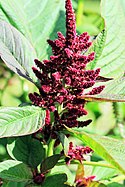
|
NYFA: X |
USDA-X Images Wikispecies |
L. 1753. Amaranthus spinosus L. |
Spiny amaranth, Thorny amaranth, Carelessweed |
Introduced from neotropics, Naturalized, SNA FACU Annual, Herb-forb |

|
NYFA: Xn |
USDA- ARS-GRIN BONAP Images Wikispecies |
| |||||
Amaranthus subg. Albersia
[edit | edit source] |
| Genus Amaranthus subg. Albersia | Pigweed | N.Y. Status | Images | Distribution | NY NPT |
Raf. |
Seabeach amaranth ⓘ
Coast amaranth ⓘ
|
Native, CoC: 10, Threatened, S2, G2, NYNHP: 1[1] FACW Annual, Herb-forb |

|
Kings (1876-1877), Nassau (1902-1998), Queens (1888-1995), Suffolk (1873-1992) NYFA: 2 |
USDA-N0 Go Botany ARS-GRIN FNA BONAP Images Wikispecies Note: FWS |
L. 1759. Amaranthus albus L. 1894. A. graecizansvar. pubescens Uline & W.L.Bray 1912. Amaranthus pubescens Rydb. 1945. A. albusvar. pubescens Fernald auct. Amaranthus graecizans non L. |
Prostrate pigweed, Tumble pigweed, Tumbleweed, White amaranth |
Introduced from tropical America, Naturalized, SNA FACU Annual, Herb-forb |
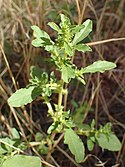
|
NYFA: X |
USDA-XW Go Botany ARS-GRIN FNA Images Wikispecies |
S.Watson 1877. Amaranthus blitoides S.Watson auct. Amaranthus graecizans non L. |
Prostrate pigweed, Prostrate amaranth, Matweed, Matweed amaranth |
Introduced from NA Southwest |

|
NYFA: X |
USDA-XX ARS-GRIN ITIS FNA Images Wikispecies |
S.Watson 1877. Amaranthus palmeri S.Watson |
Carelessweed, Palmer’s amaranth |
Introduced from NA Southwest, Potentially invasive |

|
NYFA: X |
USDA-NX ARS-GRIN ITIS FNA Images Wikispecies |
L. 1753. Amaranthus blitum L. |
Purple amaranth, Livid amaranth Amarante livide |
Introduced from Eurasia, Africa |

|
NYFA: X |
USDA-XX ARS-GRIN Images Wikispecies |
(Lesp. & Thev.) N. Terracc. |
Crispleaf amaranth, Crisp-leaved amaranth |
Introduced | 
|
NYFA: X |
USDA-X0 Images Wikispecies |
L. |
Low amaranth, Large-fruited amaranth |
Introduced, Impersistent |
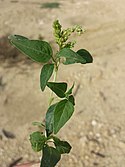
|
NYFA: X |
USDA-X0 Images Wikispecies |
| Slender amaranth, Tropical green amaranth, Green amaranth |
Introduced, N. America native, Not naturalized |

|
NYFA: Xm |
USDA-N0 Images Wikispecies | |
Celosia
[edit | edit source]| Genus Celosia | Cockscomb | N.Y. Status | Images | Distribution | NY NPT |
L. 1753. Celosia argentea L. |
Silver cockscomb ⓘ |
Introduced from tropical Africa, Not naturalized UPL-FACU Annual, Herb-forb |

|
Steuben (1924) NYFA: Xm |
USDA-X0 POWO Go Botany-0 Images Wikispecies |
L. 1753. Celosia cristata L.
1891. Celosia argentea var. cristata (L.) Kuntze
1934. Celosia argentea f. cristata (L.) Schinz |
Fasciated cockscomb ⓘ
Crested cock's-comb ⓘ |
Introduced from Caribbean, Not naturalized, SNA |
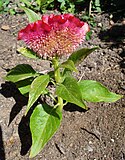
|
Tompkins (1933) NYFA: Xm |
Go Botany Images Wikispecies |
|
| |||||
Subfamily Achyranthoideae
[edit | edit source]The Achyranthoideae
Achyranthes
[edit | edit source] As of 2021, Achyranthes bidentata has been observed in Ontario Provincial Parks on two islands in western Lake Erie and in southern Ohio.[3] |
| Genus Achyranthes L. | Chaff flower | N.Y. Status | Images | Distribution | NY NPT |
(Miq.) Nakai 1865. A. bidentatavar. japonica Miq. 1920. Achyranthes japonica (Miq.) Nakai |
Japanese chaff flower | Introduced from eastern Asia, Highly invasive, NYIS: 71%[1], Prohibited[2] |

|
USDA-X0 ARS-GRIN ITIS FNA Tropicos Images Wikispecies | |
Subfamily Gomphrenoideae
[edit | edit source]The Gomphrenoideae ...
Alternanthera
[edit | edit source] |
| Genus Alternanthera | Joyweed | N.Y. Status | Images | Distribution | NY NPT |
Kunth 1753. Achyranthes repens L. 1817. Alternanthera pungens Kunth 1821. Alternanthera repens (L.) Link non J.F.Gmel. 1915. Achyranthes leiantha (Seub.) Standl. |
Khakiweed, Khaki joyweed |
Introduced, Imperistent, No specimens |

|
NYFA: X |
USDA-X0 Go Botany ARS-GRIN ITIS FNA Tropicos BONAP Images Wikispecies |
(Mart.) Griseb. 1825. Bucholzia philoxeroides Mart.
1879. Alternanthera philoxeroides (Mart.) Griseb. |
Alligatorweed ⓘ
Alligator-weed ⓘ |
Introduced from South America, Highly invasive, NYS Tier 1b |

|
NYFA: 0 counties iNat |
Images Wikispecies |
|
| |||||
Froelichia
[edit | edit source] |
| Genus Froelichia | Snakecotton | N.Y. Status | Images | Distribution | NY NPT |
(Hook.) Moq. 1840. Oplotheca gracilis Hook. 1849. Oplotheca texana A.Braun 1849. Froelichia gracilis (Hook.) Moq. 1903. F. texana A.Braun ex Small illeg. 1917. F. braunii Standl. |
Slender cottonweed, Slender cotton-weed, Slender snakecotton, Slender snake-cotton |
Introduced from sw North America, Moderately invasive, NYIS: 53%[1] |

|
Erie, Kings, Monroe, Nassau, Orange, Putnam, Queens, Richmond, Suffolk NYFA: X |
USDA-NX Go Botany ARS-GRIN ITIS FNA Tropicos BONAP Images Wikispecies |
Gomphrena
[edit | edit source]| Genus Gomphrena | Globe-amaranth | N.Y. Status | Images | Distribution | NY NPT |
L. 1753. Gomphrena globosa L. |
Globe-amaranth, Common globe amaranth, Bachelor's-button |
Introduced, Impersistent, Cultivated |

|
NYFA: Xm |
USDA-X0 ARS-GRIN ITIS FNA Images Wikispecies |
Gill. ex Moq. 1849. Gomphrena martiana Gill. ex Moq. |
Globe amaranth | Introduced, Impersistent |

|
NYFA: Xm |
USDA-X0 ITIS FNA Images Wikispecies |
|
| |||||
Subfamily Polycnemoideae
[edit | edit source]The Polycnemoideae ... NYFA includes Polycnemum in the Chenopodiaceae.
Polycnemum
[edit | edit source]| Genus Polycnemum | Needleleaf | N.Y. Status | Images | Distribution | NY NPT |
A.Braun ex Bogenh. 1841. Polycnemum majus A.Braun Polycnemum arvense var. simplex Wallr. Polycnemum arvense ssp. majus Briq. |
Giant needleleaf, Giant needle-leaf Grand polycnème |
Introduced from Europe, Turkey, Impersistent Annual, Herb-forb |

|
NYFA: Xm |
USDA-XX Go Botany VASCAN ARS-GRIN ITIS FNA Tropicos NatureServe BONAP IPN Images Wikispecies |
|
| |||||
Subfamily Salicornioideae
[edit | edit source]The Salicornioideae ...
Tribe Salicornieae
[edit | edit source]Salicornia
[edit | edit source]| Genus Salicornia | Glasswort, Pickleweed |
N.Y. Status | Images | Distribution | NY NPT |
Standl. 1753. Salicornia virginica L. p.p.
1907. Salicornia europaea var. pachystachya (W.D.J.Koch) Fernald
1916. Salicornia depressa Standl.
1947. Salicornia europaea var. simplex (Pursh) Fernald
auct.. Salicornia europaea non L. |
Glasswort, Virginia glasswort, American glasswort, Low glasswort, Saltwort Salicorne de Virginie |
Native, Secure OBL Perennial, Herb-forb, Subshrub |

|
NYFA: 5 |
USDA-NN Go Botany VASCAN ARS-GRIN ITIS FNA Tropicos Images Wikispecies |
Michx. Salicornia ambigua
Salicornia perennis in…
Salicornia virginica in…
Sarcocornia pacifica in… |
Perennial glasswort ⓘ
|
Native, CoC: 8, Likely secure OBL Perennial, Herb-forb |

|
NYFA: N4 |
Images Wikispecies |
Torr. 1858. Salicornia bigelovi Torr. auct. Salicornia mucronata non Lag. |
Dwarf saltwort, Dwarf glasswort |
Native, Threatened |

|
NYFA: 2-3 |
USDA- Images Wikispecies |
|
| |||||
Sarcocornia
[edit | edit source]| Genus Sarcocornia | Swampfire | N.Y. Status | Images | Distribution | NY NPT |
| Samphire, Chicken claws, Glasswort, Saltwort |
Native, Likely secure |

|
NYFA: 4 |
Images Wikispecies | |
|
| |||||
Subfamily Camphorosmoideae
[edit | edit source]The Camphorosmoideae
Tribe Suaedeae
[edit | edit source]Suaeda
[edit | edit source]| Genus Suaeda Forssk. ex J.F. Gmel. 1776 | Seepweed | N.Y. Status | Images | Distribution | NY NPT |
(Hook.) Moq. 1838. Chenopodium calceoliforme Hook. 1840. Suaeda calceoliformis Moq. 1874. Suaeda depressavar. erecta 1907. Suaeda americana (Pers.) Fernald 1909. Suaeda erecta A.Nelson 1912. Dondia calceoliformis Rydb. |
Horned sea-blite, Pursh seepweed, Pursh’s seepweed, American sea-blite, Broom seepweed Suéda couché |
Native, Likely secure |

|
NYFA: 4 |
USDA-NN Go Botany VASCAN ARS-GRIN FNA Tropicos Images Wikispecies |
(Elliott) Moq. 1817. Salsola linearis Elliott 1840. Suaeda linearis Moq. 1849. Chenopodina linearis Moq. 1898. Dondia linearis A.Heller |
Annual seepweed, Narrow-leaf sea-blite, Southern sea-blite |
Native, Endangered |

|
NYFA: 1 |
USDA-X0 Go Botany ITIS FNA Tropicos Images Wikispecies |
Bassett & Crompton 1978. Suaeda rolandii Bassett & Crompton |
Roland's sea-blite Suéda de Roland |
Native, Endangered, NYNHP: 1[1] |
NYFA: 1 |
USDA-NN VASCAN ITIS FNA Images Wikispecies | |
(L.) Dumort. 1753. Chenopodium maritimum L. 1827. Suaeda maritima Dumort. |
Herbaceous seepweed, White sea-blite Suéda maritime |
Introduced from North Atlantic coast, N. America native |

|
NYFA: X |
USDA-MN Go Botany VASCAN FNA Images Wikispecies |
Tribe Camphorosmeae
[edit | edit source]Bassia
[edit | edit source] |
| Genus Bassia All. | Smotherweed | N.Y. Status | Images | Distribution | NY NPT |
A.J.Scott 1753. Chenopodium scoparium L. 1809. Kochia scoparia Schrad. 1809. Kochia scopariassp. scoparia 1908. Kochia alata Bates 1978. Bassia scoparia A.J.Scott |
Summer-cypress, Burningbush, Common kochia, Mexican fireweed, Red belvedere Kochia à balais |
Introduced from Eurasia, Moderately invasive, NYIS: 69%[1] |

|
NYFA: X |
USDA-XX Go Botany VASCAN ARS-GRIN ITIS FNA Tropicos Images Wikispecies |
(Pall.) Kuntze 1771. Salsola hyssopifolia Pall. 1802. Kochia hyssopifolia Roth 1804. Suaeda hyssopifolia Pall. 1840. Echinopsilon hyssopifolium Moq. 1891. Bassia hyssopifolia Kuntze |
Fivehorn smotherweed, Five-horned smother-weed, Five-hooked bassia Bassia à feuilles d'hysope |
Introduced from Eurasia, Potentially invasive |

|
NYFA: X |
USDA-XX Go Botany VASCAN ARS-GRIN ITIS FNA Tropicos Images Wikispecies |
Spirobassia
[edit | edit source]| Genus Spirobassia Freitag & G.Kadereit | Contorted smotherweed | N.Y. Status | Images | Distribution | NY NPT |
(L.) Freitag & G.Kadereit 1753. Chenopodium hirsutum L. 1834. Echinopsilon hirsutum Moq. 1867. Bassia hirsuta Asch. 2011. Spirobassia hirsuta Freitag & al. |
Hairy smother-weed | Introduced | 
|
NYFA: X |
USDA-X0 Go Botany FNA Images Wikispecies |
|
| |||||
Subfamily Salsoloideae
[edit | edit source]The Salsoloideae ...
Tribe Salsoleae
[edit | edit source]In 2007, Hossein Akhani et al. transferred a number of Old World Salsola species to the resurected genus Kali Mill. (1754).[1] As of 2014, the North American sources used here had not chosen to abide by this transferal (though Wikipedia, Wikispecies, and Wikimedia Commons had made the change several years earlier).
|
Salsola
[edit | edit source] |
| Genus Salsola L. 1753 | Russian thistle | N.Y. Status | Images | Distribution | NY NPT |
L. 1756. Salsola tragus L.
1771. Kali tragus (L.) Scop.
1828. Salsola kali var. tenuifolia Tausch
1881. Salsola kali ssp. tragus Nyman
1908. Salsola kali ssp. iberica Sennen & Pau
1909. Salsola pestifer A.Nelson
1973. Salsola iberica (Sennen & Pau) Botsch. ex Czerep.
1993. Salsola tragus var. tenuifolia (Tausch) Tzvelev |
Russian thistle, Tumbleweed, Prickly Russian thistle Soude roulante, Chardon de Russie, Soude de Ruthénie |
Introduced from Eurasia, n. Africa, Potentially invasive, iMapInvasives, Naturalized |
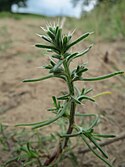
|
NYFA: X NYFA: 29 counties iNat GBIF 1 county |
USDA-XX POWO Go Botany ARS-GRIN FNA Images Wikispecies |
L. 1753. Salsola kali L.
1794. Kali soda Moench
1827. Salsola turgida Dumort
1838. Corispermum pilosum Raf.
1961. Salsola kali ssp. austroafricana Aellen
2011. Kali turgidum (Dumort.) Gutermann[1] |
Northern saltwort ⓘ
Russian thistle
Common saltwort
Salt-bush
|
Introduced from Europe, Potentially invasive, GRIIS-US: Invasive |

|
NYFA: X NYFA: 10 counties iNat GBIF 6 counties |
USDA-XW POWO Go Botany VASCAN ARS-GRIN ITIS FNA Tropicos Images Wikispecies |
(Pall.) Iliin 1803. Salsola kali var. pontica Pall.
1936. Salsola pontica (Pall.) Iliin
1993. Salsola pontica var. glabra Tzvelev
1996. Salsola kali ssp. pontica (Pall.) Mosyakin
1999. Salsola tragus ssp. pontica (Pall.) Rilke
2011. Kali ponticum (Pall.) Sukhor.[2]
2012. Kali tragus ssp. ponticum (Pall.) Mosyakin
2017. Salsola squarrosa ssp. pontica (Pall.) Mosyakin |
Southern saltwort ⓘ
Russian thistle
Prickly Russian thistle
|
Introduced, No sepecimens |
NYFA: X0 NYFA: Bronx (1899) iNat No observations |
USDA-X0 POWO Go Botany ITIS FNA Tropicos Images Wikispecies | |
Pall. 1803. Salsola collina Pall.
1913. Salsola chinensis Gand.
1974. Salsola kali ssp. collina Bolòs & Vigo in Butl.
2007. Kali collina Akhani & E.H.Roalson[3] |
Slender saltwort ⓘ
Slender Russian thistle
Tumbleweed
|
Introduced from Eurasia |

|
NYFA: X NYFA: 2 counties iNat No observations |
USDA-XX POWO Go Botany ARS-GRIN FNA Tropicos Images Wikispecies |
| |||||
Subfamily Corispermoideae
[edit | edit source]The Corispermoideae ...
Corispermum
[edit | edit source]| Genus Corispermum | Bugseed | N.Y. Status | Images | Distribution | NY NPT |
(Nutt.) Nutt. var. americanum 1753. C. hyssopifolium auct. non L.
1786. C. orientale auct. non Lam.
1818. C. hyssopifolium var. americanum Nutt.
1834. C. americanum Nutt.
1903. C. marginale Rydb
1910. C. simplicissimum Lunell |
American bugseed Corisperme à feuilles d'hysope |
Introduced, N. America native |

|
NYFA: X |
USDA-NN VASCAN ITIS FNA Tropicos Images Wikispecies |
Steven 1753. C. hyssopifolium auct. non L.
1817. C. pallasii Steven
1898. C. hyssopifolium var. leptopterum Asch.
1929. C. leptopterum (Asch.) Iljin
1929. C. sibiricum Iljin |
Pallas bugseed, Siberian bugseed Corisperme à fruit ailé |
Introduced, N. America native |
NYFA: X |
USDA-XN VASCAN ITIS FNA Tropicos Images Wikispecies | |
Kit. ex Schult. 1814. Corispermum nitidum Kit. |
Shiny bugseed, Slender bugseed |
Introduced from Europe |
NYFA: Xm |
USDA-Excluded ARS-GRIN ITIS FNA Tropicos Images Wikispecies | |
|
| |||||
Subfamily Chenopodioideae
[edit | edit source]The tribal organization used here for the Chenopodioideae is from Kadereit et. al. (2010).[1]
Tribe Axyrideae
[edit | edit source]Axyris
[edit | edit source]| Genus Axyris | Russian-pigweed | N.Y. Status | Images | Distribution | NY NPT |
L. 1753. Axyris amaranthoides L. |
Russian-pigweed, Upright axyris Ansérine de Russie |
Introduced from Eurasia, Invasive |
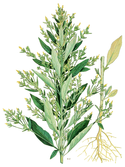
|
NYFA: X |
USDA-XX Go Botany VASCAN ARS-GRIN ITIS FNA Tropicos Images Wikispecies |
| |||||
Tribe Dysphanieae
[edit | edit source]Dysphania
[edit | edit source]| Genus Dysphania | Glandular-goosefoot | N.Y. Status | Images | Distribution | NY NPT |
(L.) Mosyakin & Clemants 1753. Chenopodium ambrosioides L. 1985. Teloxys ambrosioides W.A.Weber 2002. Dysphania ambrosioides Mosyakin & Clemants |
Mexican-tea, Worm-seed |
Introduced | 
|
NYFA: X |
USDA-XX Go Botany Images Wikispecies |
(L.) Mosyakin & Clemants 1753. Chenopodium anthelminticum L. 1867. C. ambrosioidesvar. anthelminticum A.Gray 2002. Dysphania anthelmintica |
Wormseed | Introduced | 
|
NYFA: X |
Go Botany ARS-GRIN Images Wikispecies |
| Jerusalem-oak, Jerusalem oak goosefoot, Feather-geranium |
Introduced | 
|
NYFA: Xn |
USDA-XX Go Botany ARS-GRIN Images Wikispecies | |
| Fetid goosefoot, Fetid glandular-goosefoot |
Introduced from Southwest |
Go Botany Images Wikispecies | |||
| Cut-leaved goosefoot | Introduced | Images Wikispecies | |||
| Clammy goosefoot, Ridged goosefoot, Small crumbweed |
Introduced | Images Wikispecies | |||
|
| |||||
Teloxys
[edit | edit source]| Genus Teloxys | Wormseed | N.Y. Status | Images | Distribution | NY NPT |
(L.) Moq. 1753. Chenopodium aristatum L. 1834. Teloxys aristata Moq. 2002. Dysphania aristata |
Pigweed, Wormseed |
Introduced, Impersistent |
NYFA: Xm |
USDA-XX ARS-GRIN ITIS FNA Images Wikispecies | |
|
| |||||
Cycloloma
[edit | edit source]| Genus Cycloloma | Pigweed | N.Y. Status | Images | Distribution | NY NPT |
(Spreng.) J.M.Coult. 1801. Salsola atriplicifolia Spreng. 1894. Cycloloma atriplicifolium J.M.Coult. |
Winged pigweed, Tumbling-ringwing |
Introduced | 
|
NYFA: X |
USDA-NN ITIS FNA Images Wikispecies |
|
| |||||
Tribe Anserineae
[edit | edit source]Anserineae Dumort., Fl. Belg.: 20. 1827. = Spinacieae Moq., Chenop. Monogr. Enum.: 5, 48. 1840.[1]
Blitum
[edit | edit source]| Genus Blitum L. 1753 | Goosefoot | N.Y. Status | Images | Distribution | NY NPT |
Schult. 1822. Blitum nuttallianum Schult. 1891. Monolepis nuttalliana Greene |
Poverty-weed, Nuttall's poverty-weed Ansérine hastée |
Introduced, N. America native, Impersistent |

|
NYFA: Xm |
USDA-NN Go Botany VASCAN ARS-GRIN ITIS FNA Tropicos Images Wikispecies |
L. ssp. capitatum 1753. Blitum capitatum L. 1753. Blitum capitatumssp. capitatum [2]1857. Chenopodium capitatum Ambrosi p.p. 1857. Chenopodium capitatumvar. capitatum |
Strawberry goosefoot, Strawberry-blight, Indian-paint, Indian ink, Blite goosefoot, Strawberry-spinach Chénopode capité |
Introduced, N. America native |

|
NYFA: X4 |
USDA-NN Go Botany VASCAN ARS-GRIN ITIS FNA Images Wikispecies |
(L.) C.A.Mey. 1753. Chenopodium bonus-henricus L. 1766. Atriplex bonus-henricus Crantz 1827. Anserina bonus-henricus Dumort. 1829. Blitum bonus-henricus C.A.Mey. 1834. Agathophytum bonus-henricus Moq. |
Good King Henry, Allgood, Fat-hen, Perennial goosefoot, Wild spinach Chénopode Bon-Henri, Ansérine bon-henri, Bon-Henri |
Introduced from Europe |
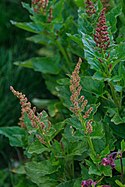
|
NYFA: X |
USDA-XX Go Botany VASCAN ARS-GRIN ITIS FNA Tropicos Images Wikispecies |
L. 1753. Blitum virgatum L. 1794. Morocarpus foliosus Moench 1815. Chenopodium virgatum Thunb. 1864. Chenopodium foliosum Asch. |
Leafy goosefoot | Introduced from Eurasia, Impersistent |

|
NYFA: Xm |
USDA-XX Go Botany ARS-GRIN ITIS FNA Tropicos Images Wikispecies |
| |||||
Spinacia
[edit | edit source]| Spinach (Spinacia oleracea) is commonly grown as a garden vegetable but is not known to naturalize in New York.
|
| Genus Spinacia L. 1753 | Spinach | N.Y. Status | Images | Distribution | NY NPT |
L. 1753. Spinacia oleracea L.
1753. Spinacea oleracea L. orth. var.
1794. Spinacia inermis Moench
1794. Spinacia spinosa Moench
1846. Spinacia oleracea var. inermis (Moench) Peterm. |
Spinach Épinard |
Introduced from Eurasia, Cultivated, Adventive, Not naturalized, SNA, GNR Annual, Herb-forb |

|
NYFA: Xm |
USDA-XX Go Botany VASCAN ARS-GRIN ITIS FNA Tropicos Images Wikispecies |
|
| |||||
Tribe Chenopodieae
[edit | edit source]Fuentes-Bazan et al. (2012) moved a number of species out of Chenopodium to make it monophyletic, calling one of the new segregate genera Chenopodiastrum. The genera that were phylogenically between the Chenopodium and Chenopodiastrum clades were already in the tribe Atripliceae, so they placed Chenopodium and the new Chenopodiastrum in Atripliceae, even though the original Atripliceae would then be surrounded by and outnumbered by the former members of the Chenopodieae. But ARS-GRIN, though recognizing the new Chenopodiastrum, places all of these genera in Chenopodieae and calls Atripliceae a synonym.[1] That's the convention used here for this tribe.
|
Lipandra
[edit | edit source]| Genus Lipandra | Goosefoot | N.Y. Status | Images | Distribution | NY NPT |
(L.) S.Fuentes, Uotila & Borsch var. polysperma 1753. Chenopodium polyspermum L. 2012. Lipandra polysperma S.Fuentes et al. |
Manyseed goosefoot, Many-seeded goosefoot Chénopode polysperme, Chénopode à nombreuses graines |
Introduced, Impersistent |

|
NYFA: Xm |
USDA-XX Go Botany VASCAN ARS-GRIN ITIS Tropicos IPN Images Wikispecies |
(L.) S.Fuentes, Uotila & Borsch var. acutifolia Mosyakin 1805. Chenopodium acutifolium Sm. 1828. C. polyspermumvar. acutifolium Gaudin 2013. L. polyspermavar. acutifolia Mosyakin |
Many-seeded goosefoot, Acute-leaved goosefoot Chénopode à feuilles aiguës |
Introduced, Impersistent |

|
NYFA: Xm |
USDA-XX Go Botany VASCAN ARS-GRIN ITIS FNA IPN Images Wikispecies |
|
| |||||
Oxybasis
[edit | edit source] |
| Genus Oxybasis | Goosefoot | N.Y. Status | Images | Distribution | NY NPT |
(L.) S.Fuentes, Uotila & Borsch var. rubra 1753. Chenopodium rubrum var. rubrum autonym
2012. Oxybasis rubra var. rubra autonym |
Red pigweed, Red goosefoot, Coast-blite goosefoot Chénopode rouge, Ansérine rouge |
Native, Threatened |

|
NYFA: 2 |
USDA-NN Go Botany VASCAN Images Wikispecies |
(L.) S.Fuentes et al. ssp. glauca 1753. Chenopodium glaucumvar. glaucum 2012. Oxybasis glaucavar. glauca |
Oak-leaved goosefoot | Introduced from western North America, N. America native |

|
NYFA: X |
USDA-XN Go Botany VASCAN ARS-GRIN FNA Images Wikispecies |
(L.) S. Fuentes, Uotila & Borsch 1753. Chenopodium urbicum L.
2012. Oxybasis urbica in… |
Urban goosefoot ⓘ
City goosefoot ⓘ
|
Introduced from Eurasia, Unknown naturalization |

|
NYFA: Xu |
USDA-XX ARS-GRIN Images Wikispecies |
(L.) S.Fuentes, Uotila & Borsch 1771. Blitum chenopodioides L. 1933. Chenopodium chenopodioides Aellen 2012. Oxybasis chenopodioides S.Fuentes et al. |
Low goosefoot, Saltmarsh goosefoot Chénopode à feuilles grasses |
Introduced from Eurasia, northern Africa, western N. America |

|
NYFA: X |
USDA-NN VASCAN ARS-GRIN FNA Images Wikispecies |
| Genus Oxybasis (excluded taxa) | Goosefoot | N.Y. Status | Images | Distribution | NY NPT |
(L.) S.Fuentes et al. var. humilis (Hook.) Mosyakin 1838. Chenopodium humile Hook. 1880. C. rubrumvar. humile S.Watson 1971. C. rubrumssp. humile Hultén 2013. O. rubravar. humilis Mosyakin |
Coast-blite goosefoot, Marshland goosefoot |
Introduced from western N. America, Canada native |

|
NYFA: X |
USDA-XN Go Botany VASCAN ARS-GRIN ITIS FNA Tropicos Images Wikispecies |
|
| |||||
Chenopodiastrum
[edit | edit source]| Genus Chenopodiastrum S.Fuentes et al. 2012 | Goosefoot | N.Y. Status | Images | Distribution | NY NPT |
(Torr.) S.Fuentes, Uotila & Borsch 1827. Chenopodium hybridumvar. simplex Torr. 1832. Chenopodium simplex Raf. 1929. Chenopodium gigantospermum Aellen 2012. Chenopodiastrum simplex S.Fuentes &al. |
Giant-seeded goosefoot, Maple-leaved goosefoot |
Native, Secure |

|
NYFA: 5 |
USDA-NN Go Botany ARS-GRIN FNA Images Wikispecies |
(L.) S.Fuentes, Uotila & Borsch 1753. Chenopodium murale L. 2012. Chenopodiastrum murale S.Fuentes &al. |
Nettle-leaved goosefoot, Australian-spinach |
Introduced from Eurasia, northern Africa |

|
Go Botany ARS-GRIN Images Wikispecies | |
|
| |||||
Atriplex
[edit | edit source]| Genus Atriplex L. 1753 | Saltbush | N.Y. Status | Images | Distribution | NY NPT |
Humb. & Bonpl. ex Willd. 1806. A. cristata Humb. & Bonpl. ex Willd.
A. arenaria Nutt.
A. littoralis (Jacq.) Fawc. & Rendle
A. pentandra (Jacq.) Standl. |
Crested saltbush | Native, Vulnerable |

|
NYFA: 3? |
USDA-N0 Go Botany Images Wikispecies |
non (Nutt.) J.F.Macbr. (1918) nom. illeg. 1817. Atriplex dioica Raf. 1818. Chenopodium subspicatum Nutt. 1874. A. patulavar. subspicata S.Watson 1906. Atriplex subspicata Rydb. |
Saline saltbush, Thickleaf orach, Thick-leaved orach |
Native, Endangered |
NYFA: 1 |
USDA-N0 Go Botany VASCAN ARS-GRIN ITIS FNA Tropicos IPN Images Wikispecies | |
Edmondston 1845. Atriplex glabriuscula Edmondston 1923. Atriplex patulassp. glabriuscula H.M. Hall & Clem. |
Northeastern saltbush, Glabrous orach, Seaside orach, Scotland Orache, Bracted orache Arroche glabriuscule |
Native, Endangered, Note:[1] |

|
NYFA: 1 |
USDA-NN Go Botany VASCAN ITIS FNA Tropicos Images Wikispecies |
| Creeping saltbush, Fat-hen, Thin-leaved orach, Hastate-leaved orache, Triangle orache |
N. America native | 
|
NYFA: Un |
USDA-NN Go Botany Images Wikispecies | |
L. 1753. Atriplex patula L. 1753. Atriplex litoralis L. 1804. Atriplex angustifolia Sm. 1872. Teutliopsis patula Čelak. 1902. A. hastatassp. patula E.Pons 1904. A. hastatavar. patula Farw. 1923. A. patulassp. typica H.M.Hall & Clem. |
Halberd-leaved saltbush, Spear orach, Spearscale Arroche étalée, Arroche des champs |
Introduced from Eurasia, northern Africa |

|
NYFA: 5 |
USDA-XX Go Botany VASCAN ARS-GRIN ITIS FNA Tropicos IPN Images Wikispecies |
L. 1753. Atriplex hortensis L. 1753. Atriplex hortensisvar. rubra L. 1803. Atriplex nitens Schkuhr |
Garden orache, Garden saltbush, French spinach, Mountain-spinach Arroche des jardins, Arroche rouge des jardins, Bonne-dame |
Introduced from southern Europe? |

|
NYFA: X |
USDA-XX Go Botany VASCAN ARS-GRIN FNA Tropicos Images Wikispecies |
| Frosted orache, Belgian orach |
Introduced | 
|
Images Wikispecies | ||
L. |
Tumbling orach, Tumbling saltweed |
Introduced from Eurasia, n. Africa FACU Annual, Herb-forb |

|
NYFA: 4 counties |
USDA-XX POWO FSUS FNA Images Wikispecies |
| Tartarian saltbush | Introduced | 
|
Images Wikispecies | ||
L. |
Grassleaf orache | Introduced, No specimens |

|
NYFA: D |
USDA-XX Images Wikispecies |
| |||||
Chenopodium
[edit | edit source] |
Chenopodium subsect. Favosa
[edit | edit source]| Genus Chenopodium subsect. Favosa | Goosefoot | N.Y. Status | Images | Distribution | NY NPT |
Moq. var. bushianum (Aellen) Cronquist 1929. Chenopodium bushianum Aellen ????. C. berlandierivar. acutidentatum Aellen 1991. C. berlandierivar. bushianum Cronquist auct. C. paganum non Reichenb. |
Bush's goosefoot, Bush's pigweed, Pit-seeded goosefoot |
Native, Secure |

|
NYFA: 5 |
USDA-NN Go Botany ARS-GRIN ITIS FNA Tropicos IPN Images Wikispecies |
var. boscianum Wahl 1840. Chenopodium boscianum Moq 1954. C. berlandierivar. boscianum Wahl |
Pitseed goosefoot, Pit-seeded goosefoot |
Native, Endangered |

|
NYFA: 1? |
USDA-N0 Images Wikispecies |
Moq. var. macrocalycium Cronquist C. macrocalycium Aellen |
Pitseed goosefoot, Pit-seeded goosefoot, Large-calyx Goosefoot |
Native, Endangered |

|
NYFA: 1-2 |
USDA-NX Images Wikispecies |
| Genus Chenopodium subsect. Favosa (excluded taxa) | Goosefoot | N.Y. Status | Images | Distribution | NY NPT |
Standl. 1916. Chenopodium neomexicanum Standl. 1916. Chenopodium arizonicum Standl. 1916. Chenopodium palmeri Standl. |
New Mexico goosefoot | Introduced, US West native |
NYFA: X |
USDA-N ARS-GRIN ITIS FNA NatureServe Images Wikispecies | |
|
| |||||
Chenopodium subsect. Standleyana
[edit | edit source]| Genus Chenopodium subsect. Standleyana | Goosefoot | N.Y. Status | Images | Distribution | NY NPT |
Aellen |
Standley's goosefoot | Native, Threatened |

|
NYFA: 1-3 |
USDA-NN ITIS FNA Images Wikispecies |
|
| |||||
Chenopodium subsect. Chenopodium
[edit | edit source]| Genus Chenopodium subsect. Chenopodium | Goosefoot | N.Y. Status | Images | Distribution | NY NPT |
L. 1753. Chenopodium album L. 1820. C. browneanum Roem. & Schult. 1825. C. giganteum D. Don |
Lambs-quarters, White goosefoot, Pigweed Ansérine blanche |
Introduced from Eurasia, Potentially invasive |

|
NYFA: X |
USDA-MM Go Botany ARS-GRIN ITIS FNA Tropicos BONAP Images Wikispecies |
Schrad. ex W.D.J.Koch & Ziz 1775. Chenopodium triangulare Forssk. 1814. Chenopodium opulifolium Schrad. 1962. C. albumssp. opulifolium Maire |
Seaport goosefoot, Grey goosefoot |
Introduced from Eurasia, Africa |

|
NYFA: X |
USDA-XX ARS-GRIN FNA Tropicos Images Wikispecies |
Andrz. 1821. Chenopodium strictum Roth
1824. Salsola stricta (Roth) Spreng.
1862. Chenopodium betaceum Andrz. (i)
1894. Chenopodium album ssp. striatum (Krašan) Murr
1954. Chenopodium strictum var. glaucophyllum (Aellen) Wahl |
Striped goosefoot | N. America native, Unknown NY nativity Annual, Herb-forb |

|
NYFA: N? iNat GBIF |
USDA-NX Images Wikispecies |
L. 1753. Chenopodium vulvaria L. |
Stinking goosefoot, Arrach, Vulvaria |
Introduced, Impersistant, Not naturalized |

|
Monroe (1912-17) NYFA: Xm |
USDA-XX FNA Images Wikispecies |
|
| |||||
Chenopodium subsect. Leptophylla
[edit | edit source]| Genus Chenopodium subsect. Leptophylla | Goosefoot | N.Y. Status | Images | Distribution | NY NPT |
Rydb. |
Desert goosefoot, Narrow-leaved goosefoot |
Introduced, N. America native |
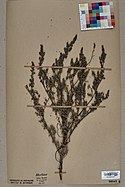
|
NYFA: Xu |
USDA-NN Images Wikispecies |
| Genus Chenopodium subsect. Leptophylla (excluded taxa) | Goosefoot | N.Y. Status | Images | Distribution | NY NPT |
| Aridland goosefoot, Narrow-leaved goosefoot |
Introduced | NYFA-Excluded |
Images Wikispecies | ||
|
| |||||
Chenopodium subsect. Fremontia
[edit | edit source]| Genus Chenopodium subsect. Fremontia (excluded taxa) | Goosefoot | N.Y. Status | Images | Distribution | NY NPT |
| Fremont's goosefoot | N. America native western, N.Y. excluded |
NYFA-Excluded |
Images Wikispecies | ||
|
| |||||
Subfamily Betoideae
[edit | edit source]The Betoideae
| Genus Beta | Beet | N.Y. Status | Images | Distribution | NY NPT |
L. 1753. Beta vulgaris L. 1762. Beta maritima L. 1882. Beta vulgarisssp. maritima Arcang. |
Beet, Common beet Betterave |
Introduced from Eurasia, northern Africa |
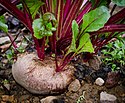
|
NYFA: X |
USDA-X0 Go Botany ARS-GRIN ITIS FNA Tropicos Images Wikispecies |
|
| |||||
Family Aizoaceae
[edit | edit source]The Aizoaceae (the fig-marigold family or ice plant family) ...
Subfamily Tetragonioideae
[edit | edit source]Tetragonia
[edit | edit source]| Genus Tetragonia | Tetragonia | N.Y. Status | Images | Distribution | NY NPT |
(Pallas) Kuntze |
New Zealand spinach | Introduced, Impersistent |

|
NYFA: X |
USDA-XX Images Wikispecies |
|
| |||||
Subfamily Sesuvioideae
[edit | edit source]Sesuvium
[edit | edit source]| Sea purslane
|
| Genus Sesuvium L. | Sea purslane | N.Y. Status | Images | Distribution | NY NPT |
(Walter) Britton, Sterns & Poggenb. 1788. Pharnaceum maritimum Walter
1821. Sesuvium pentandrum Elliott (nom. illeg.)
1824. Mollugo maritimum (Walter) Ser.
1888. Sesuvium maritimum (Walter) Britton, Sterns & Poggenb.
1891. Halimus maritima (Walter) Kuntze |
Sea purslane ⓘ
Slender sea-purslane
Annual sea-purslane ⓘ
Puerto Rico sea-purslane
|
Native, Endangered |

|
NYFA: 1 GBIF |
USDA-NN Images Wikispecies |
|
| |||||
Family Nyctaginaceae
[edit | edit source]The Nyctaginaceae (four-o'clock family)
Tribe Nyctagineae
[edit | edit source]Mirabilis
[edit | edit source]| Genus Mirabilis | Four-o'clock | N.Y. Status | Images | Distribution | NY NPT |
Heart-leaved umbrella wort ⓘ
Heartleaf four o'clock ⓘ
|
Introduced, N. America native |

|
NYFA: Xn |
USDA-NN Go Botany Images Wikispecies | |
(Walter) Heimerl 1893. Mirabilis hirsuta (Pursh) MacMill.
Mirabilis albida (Walter) Heimerl |
Pale umbrella wort ⓘ
White four-o'clock ⓘ
|
Introduced, N. America native |
NYFA: X |
USDA-N0 Go Botany Images Wikispecies | |
var. linearis |
Narrow-leaved four o'clock, Narrowleaf four o'clock |
Introduced, N. America native, Unk. naturalization |

|
NYFA: Xu |
USDA-NN Go Botany Images Wikispecies |
L. |
Marvel-of-Peru ⓘ
Marvel of Peru ⓘ
|
Introduced | 
|
NYFA: Xm |
USDA-XX Go Botany ARS-GRIN Images Wikispecies |
|
| |||||
Family Phytolaccaceae
[edit | edit source]The Phytolaccaceae (pokeweed family)...[1]
Phytolacca
[edit | edit source] American pokeweed
|
| Genus Phytolacca | Pokeweed | N.Y. Status | Images | Distribution | NY NPT |
L. var. americana 1753. Phytolacca americana L. 1762. Phytolacca decandra L. |
American pokeweed, Inkberry, Pigeonberry, Pokeberry, Virginia poke Raisin d'Amérique |
Native, Secure Perennial, Herb-forb |

|
NYFA: 5 |
USDA-NN ARS-GRIN ITIS FNA Images Wikispecies |
|
| |||||
Family Molluginaceae
[edit | edit source] carpet-weed
|
Mollugo
[edit | edit source]| Genus Mollugo | Carpetweed | N.Y. Status | Images | Distribution | NY NPT |
L. (1753) |
Carpet-weed, Green carpetweed, Indian chickweed, Mollugo verticillé |
Introduced, N. America native |

|
NYFA: X |
USDA-NX Go Botany FNA BONAP Images Wikispecies |
|
| |||||
Family Montiaceae
[edit | edit source]| The Montiaceae Raf. (1820) was adoped by APG III (2009) to house a number of genera sgregated from the Portulacaceae (purslane family). Montiaceae includes the spring ephemerals in the genus Claytonia.
|
Claytonia
[edit | edit source]| Claytonia | leaf shape | leaf length | leaf width |
|---|---|---|---|
| C. caroliniana | broad oblanceolate to oval | 25-75 mm | 10-30 mm |
| C. virginica | linear to narrow oblanceolate | 75-180 mm | 2-15 mm |
| Genus Claytonia | Spring beauty | N.Y. Status | Images | Distribution | NY NPT |
Michx. 1803. Claytonia caroliniana Michx. 1807. Claytonia spathulifolia Salisb. 1966. C. carolinianavar. spathulifolia W.H.Lewis 1975. C. carolinianavar. lewisii McNeill |
Carolina springbeauty, Carolina spring-beauty, Wide-leaved spring beauty Claytonie de Caroline, Claytonie feuille-large |
Native, Secure |

|
NYFA: 5 |
USDA-NN Go Botany VASCAN ITIS FNA Tropicos Images Wikispecies |
L. var. virginica 1753. Claytonia virginica L. 1931. Claytonia robusta (Somes) Rydb. 1831. Claytonia media (DC.) Link 1992. C. virginicavar. hammondiae J.J.Doyle &al. |
Eastern spring beauty, Virginia springbeauty, Narrow-leaf spring-beauty, Narrow-leaved spring beauty Claytonie de Virginie, Claytonie feuille-étroite |
Native, Secure |

|
NYFA: 5 |
USDA-NN Go Botany VASCAN ARS-GRIN ITIS FNA Tropicos Images Wikispecies |
|
| |||||
Family Portulacaceae
[edit | edit source]The Portulacaceae (purslane family) now contains only the genus Portulaca.[1]
|
Portulaca
[edit | edit source] common purslane
|
| Genus Portulaca | Purslane | N.Y. Status | Images | Distribution | NY NPT |
L. 1753. Portulaca oleracea L. |
Common purslane, Little hogweed |
Introduced, Canada native, Naturalized |

|
NYFA: |
USDA-XN Go Botany ARS-GRIN Images Wikispecies |
Hook. |
Garden purslane, Moss-rose, Rose moss, Rose-moss-of-garden |
Introduced, Not naturalized |

|
NYFA: X |
USDA-XW Images Wikispecies |
|
| |||||
Family Cactaceae
[edit | edit source]The Cactaceae (cactus family) has just one taxon native to New York.[1]
|
Subfamily Opuntioideae
[edit | edit source]Tribe Opuntieae
[edit | edit source]Opuntia
[edit | edit source] eastern prickly-pear |
| Genus Opuntia | Pricklypear | N.Y. Status | Images | Distribution | NY NPT |
(Raf.) Raf. (1830) |
Eastern prickly-pear | Native, Likely secure |

|
NYFA: 4 |
USDA-NN ARS-GRIN ITIS FNA Images Wikispecies |
|
| |||||
















